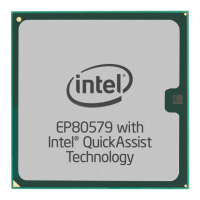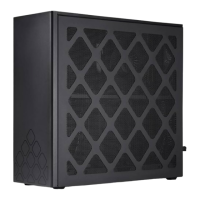Intel
®
EP80579 Integrated Processor Product Line—System Power Delivery Guide
Intel
®
EP80579 Integrated Processor Product Line
Platform Design Guide May 2010
72 Order Number: 320068-005US
typically used to derive other stand-by power planes (e.g., 3.3 VSBY, 2.5 VSBY, etc.) on
the Development Board. The power supply should be capable of handling at least 2A of
continuous standby current and at least 2.5 A of peak standby current.
Note: To ensure that enough power is available during Suspend-to-RAM (STR), a thorough
power budget should be completed. The power requirements should include each
device’s worst case power consumption, both in suspend and in full power modes. The
power requirements should be compared with the power budget supplied by the power
supply.
6.5.11 Auxiliary Voltages
6.5.11.1 PCI Express 3.3V Vaux Voltage (P3V3_AUX)
The P3V3_AUX power plane is the output of the VSBY5-to-3.3V Auxiliary Power
(P3V3_AUX) voltage regulator. The 3.3 Vaux rail powers the PCI Express Switch and
PCI Express slots’ Vaux pins.
6.5.11.2 GbE LAN 2.5V Vaux Voltage (P2V5_AUX)
The P2V5_AUX power plane is the output of VSBY2_5-to-2.5V Auxiliary Power
(P2V5_AUX) voltage regulator. The 2.5 Vaux rail powers the GbE LAN 2.5V Vaux pins.
6.5.11.3 GbE LAN 1.0V Vaux Voltage (P1V0_AUX)
The P1V0_AUX power plane is the output of VSBY1_0-to-1.0V Auxiliary Power
(P1V0_AUX) voltage regulator. The 1.0 Vaux rail powers the GbE LAN 1.0V Vaux pins.
6.6 Component Power Distribution Guidelines
Large current swings can cause the component voltage rails to drop below specified
limits. To avoid this type of situation, ensure that the appropriate amount of
capacitance is added to the various power rails. For prototype board designs, the
designer should include pads for extra power plane decoupling caps.
6.6.1 IA-32 core Power Distribution Guidelines
6.6.1.1 IA-32 core Power Requirements
The system board designer should properly place high-frequency and bulk-decoupling
capacitors as needed between the voltage regulator and processor to ensure the
voltage fluctuations remain within the core voltage specifications.
The IA-32 core requires local regulation due to its higher current requirements, and to
maintain power supply tolerance. For example, an on-board DC-to-DC converter
converts a higher DC voltage to a lower DC voltage using a switching regulator.
Distributing lower current at a higher voltage to the converter minimizes unwanted
losses (I x R). More importantly however, an on-board regulator regulates the voltage
locally, which minimizes DC line losses by reducing motherboard resistance on the core
voltage.
6.6.2 General Switching Power Supply Design Recommendations
In a single-phase topology, the duty cycle of the control (top) MOSFET (see Figure 40)
is roughly the ratio of the output voltage and the input voltage, and the bottom phase
is not implemented. Due to the small ratio between V
CC
and V
DC,
the duty cycle of the
control MOSFET is very small. The main power loss in the control MOSFET is therefore

